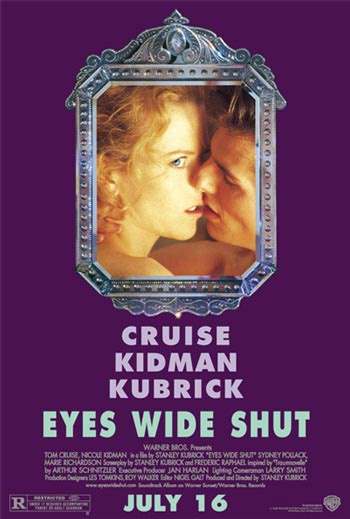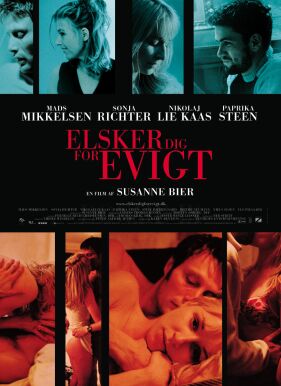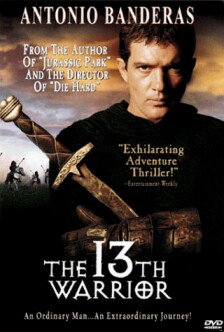Eyes Wide Shut
Never a big fan of the late Stanley Kubrick’s, I went to see Eyes Wide Shut with no very great expectations. As in so many of Kubrick’s films, the cineaste predominates over the dramatist or the moralist. He is one of those directors — Bertolucci is another — whose approach to the movies is what I think of as technological. When he begins a film his first thought isn’t to ask himself what he means to say in it so much as it is just to see what this baby can do, in terms of sheer technique. He tends to let the larger meanings take care of themselves. But in spite of the facts that the film is far too long at 145 minutes and that it is impossible to take Tom Cruise seriously as a rich doctor of 35 — or, indeed, as anything else apart from Tom Cruise, superstar — I found myself rather impressed by the technique. Then the lights came up and I found myself wondering what was the point of it all.
The cinematic dreamscape is now familiar enough that we are likely to suppose it an easy thing to produce. But in a way our dreams have been corrupted by years of movie fantasy. Last year’s What Dreams May Come tried to circumvent this problem, I think unsuccessfully, by using the works of classic painters as the basis of the dream landscape, but Kubrick takes a more subtle and dramatically pleasing route in adapting (along with Frederic Raphael) the Traumnovelle of Arthur Schnitzler. Mr Cruise’s real-life wife, Nicole Kidman, who also plays his wife in the movie, has the acknowledged dream — partly a waking sexual fantasy and partly an actual nightmare — and her husband gets to live a dream made up of the same ingredients. The counterpoint between the two parallel dream-stories, each of which threatens to divide the couple in any of several ways including death, makes its own dark commentary on the psychic energies engaged in marriage.
It is a clever idea, and once you cotton on to the fact that you are meant to be watching a living dream, a symbolic drama in which weird but significant things are happening all the time, it is more amusing than disturbing — like reviewing a nightmare after you wake up and realize that everything has turned out all right. As in dreams, the moral world is inverted: passion is the norm, restraint the exception once our daytime bonds are loosened for sleep. Most memorable is of course the orgy scene in which hundreds of cloaked and hooded figures in Venetian masks conduct a sort of satanic ritual to celebrate the fantasy of sexual availability which they are about to enact. The scene will doubtless be more impressive to foreigners than to US citizens, however, as the Motion Picture Association’s ratings board has decreed that in this country the picture cannot be exhibited without the insertion of “digitized” figures which serve the same purpose as the black strips that used to be placed over the naughty bits in photographs in the Police Gazette.
Nevertheless, the point is made clearly enough: Mr Cruise’s wealthy doctor is irresistibly drawn to the prospect of the sexual freedom he has had to give up with his marriage at the same time that some part of him realizes he cannot approach it — or any of the other opportunities that, dreamlike, the movie throws in his way — without calamitous results. The absolute destructiveness, moral and physical, of sexual licence is represented for us in a way that few who see this movie will ever forget. When Mr Cruise, wandering the night-time streets of New York in a daze, picks up a New York Post with the headline-cover, “Lucky to be Alive” (a paper in which, by the way, he learns of the death of his companion of the night before), the consciousness of his own luck is only beginning to dawn on him. But it is a luck more common than the banner headline would suggest—the luck of those who by a combination of chance and instinctive hesitation daily avoid their own impulses as well as the more obvious contingencies of disease and violence.
But the association of sex and danger is an old one — albeit with some new twists in the age of AIDS and affluence and the breakdown of old restraints — and in the final analysis Kubrick does not really have very much interesting or original to say about it. The concluding dialogue between Miss Kidman and Mr Cruise goes something like this:
“What do you think we should do?”
“Maybe we should be grateful; grateful that we have managed to survive through all our adventures, whether they were real or a dream.”
“Are you sure?”
“Only as sure as I am that the reality of one night, let alone that of a lifetime can ever be the whole truth. No dream is just a dream”
“The important thing is we’re awake now, and hopefully for a long time to come.”
“Forever?”
“Let’s not use that word. It frightens me.”
That is just abysmally bad writing and evidence, if any were needed, that Kubrick could only take his material so far before his moral vision clouded and he was left to back his way out of it with a few ill-chosen banalities. But up until that point, he did a good job of presenting late 20th century yuppiedom with a mirror in which to see and be disgusted by its own appearance.
Discover more from James Bowman
Subscribe to get the latest posts to your email.








